University Financial Accounting Report: JB HI-FI PPE Analysis 2017
VerifiedAdded on 2021/06/14
|8
|906
|25
Report
AI Summary
This report provides an analysis of JB HI-FI Limited's financial statements, specifically focusing on property, plant, and equipment (PPE). The report examines the balance of PPE, asset derecognition, and its impact on the financial statements, including the balance sheet, income statement, and cash flow statement. It delves into the company's accounting practices related to the disposal of assets, the recognition of gains and losses, and compliance with GAAP and AASB standards. The analysis includes a breakdown of the financial data from 2016 and 2017, offering insights into the company's financial performance and adherence to accounting principles. The report concludes that JB HI-FI has followed all the rules and guidelines for disclosure of the derecognition gain and loss as per the GAAP and AASB standards, with proper disclosures and workings given in the notes to accounts, the profit and loss statements, the cash flow statement and the balance sheet of the company. The bibliography includes sources used in the analysis.

Paraphrase This Document
Need a fresh take? Get an instant paraphrase of this document with our AI Paraphraser
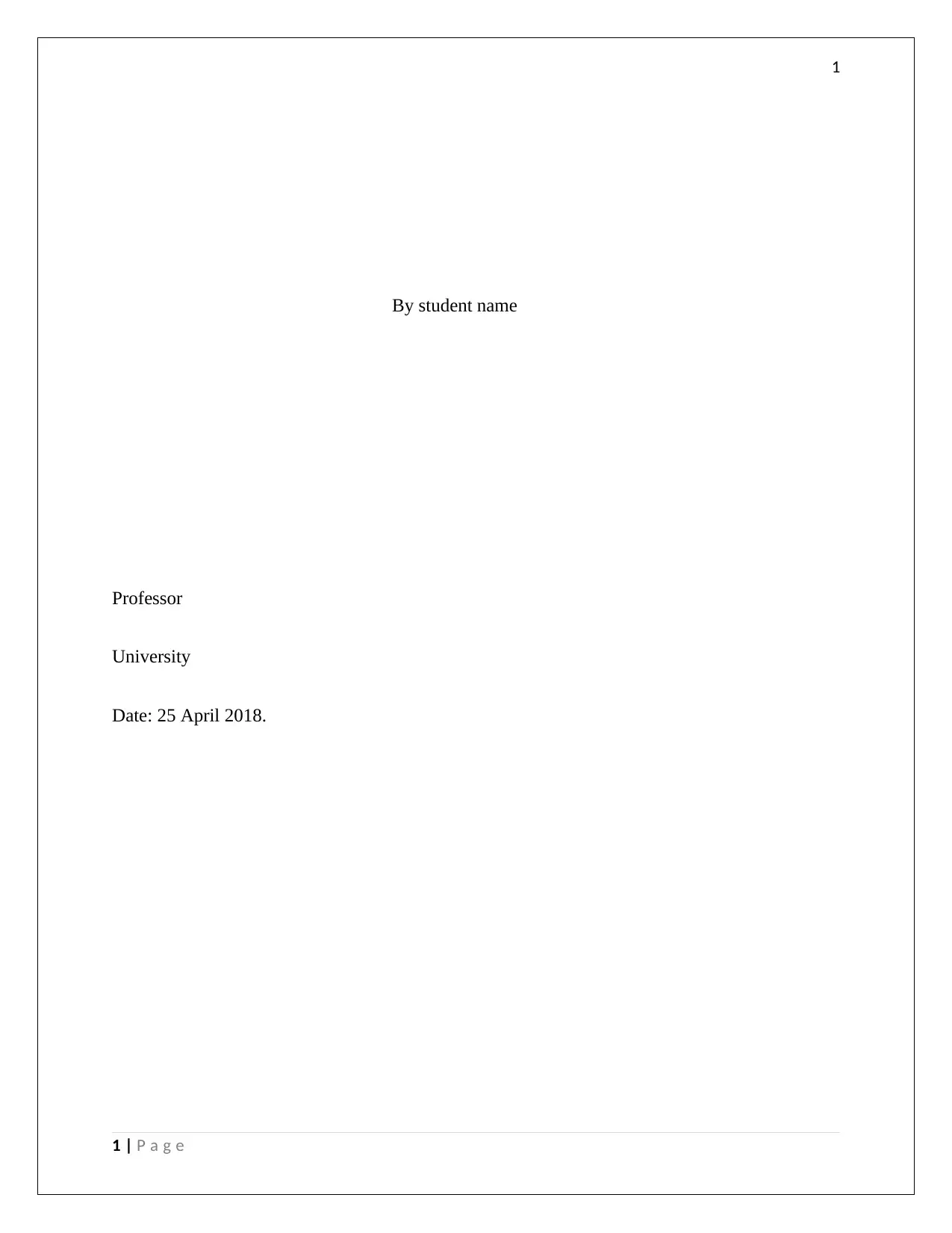
1
By student name
Professor
University
Date: 25 April 2018.
1 | P a g e
By student name
Professor
University
Date: 25 April 2018.
1 | P a g e
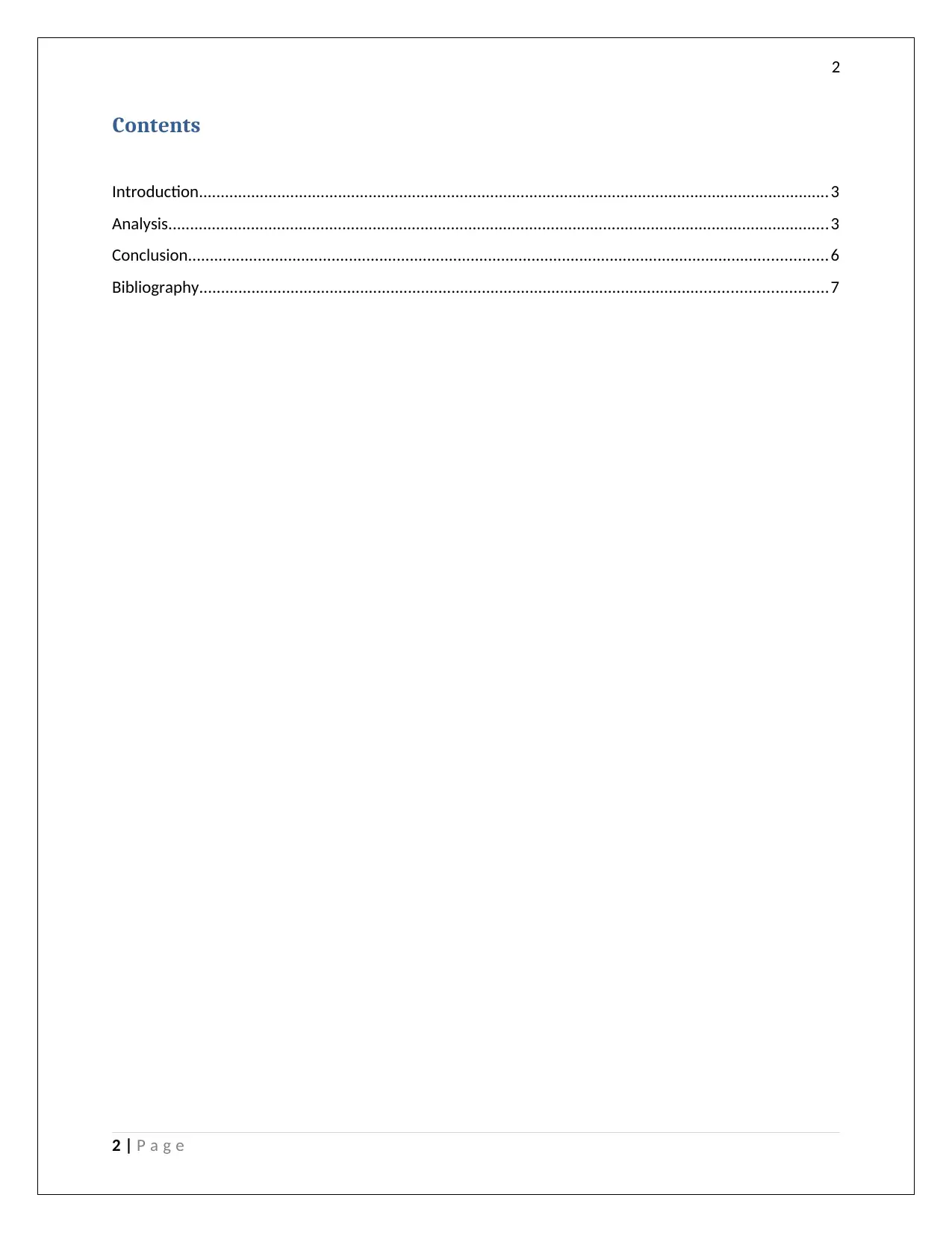
2
Contents
Introduction.................................................................................................................................................3
Analysis........................................................................................................................................................3
Conclusion...................................................................................................................................................6
Bibliography................................................................................................................................................7
2 | P a g e
Contents
Introduction.................................................................................................................................................3
Analysis........................................................................................................................................................3
Conclusion...................................................................................................................................................6
Bibliography................................................................................................................................................7
2 | P a g e
⊘ This is a preview!⊘
Do you want full access?
Subscribe today to unlock all pages.

Trusted by 1+ million students worldwide
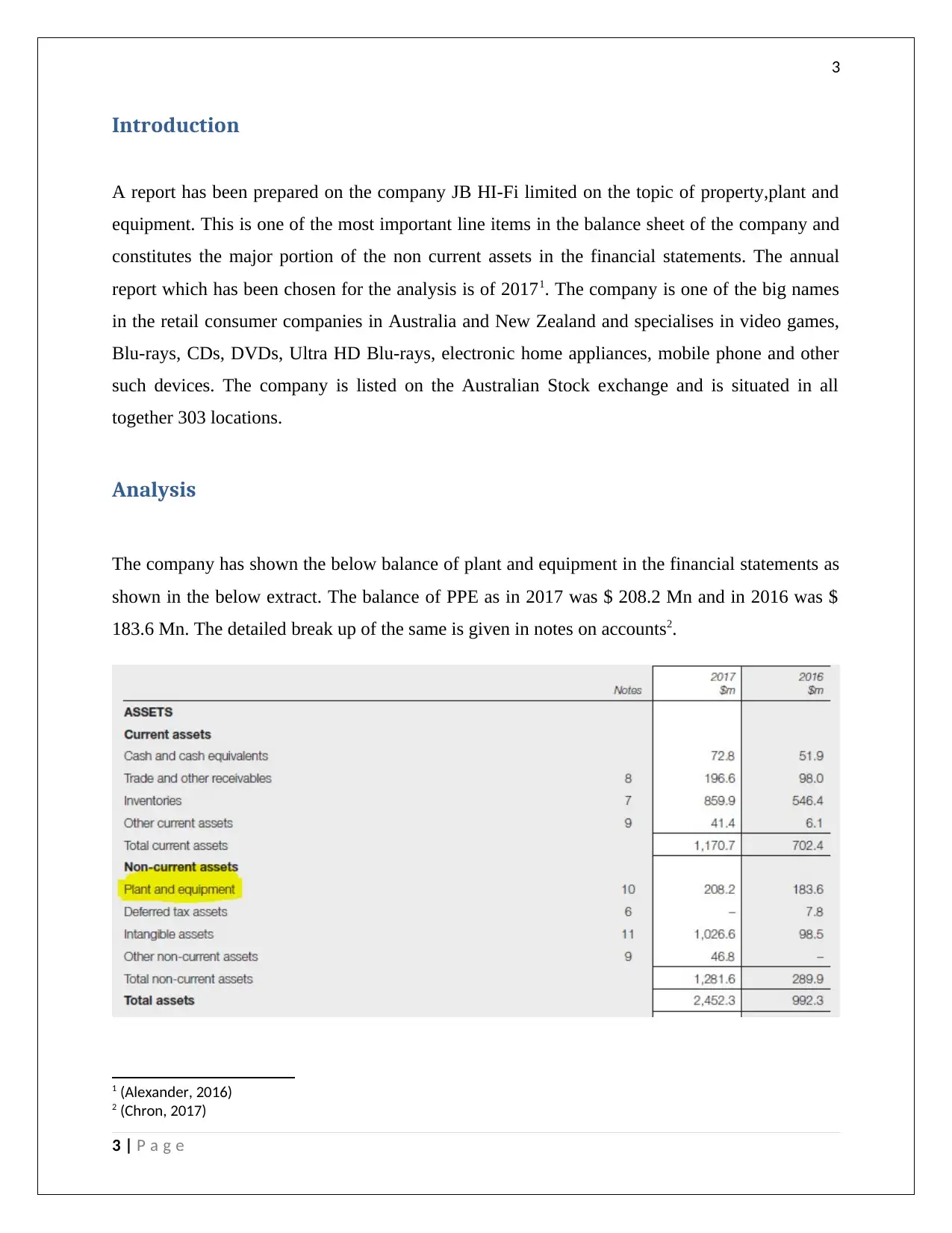
3
Introduction
A report has been prepared on the company JB HI-Fi limited on the topic of property,plant and
equipment. This is one of the most important line items in the balance sheet of the company and
constitutes the major portion of the non current assets in the financial statements. The annual
report which has been chosen for the analysis is of 20171. The company is one of the big names
in the retail consumer companies in Australia and New Zealand and specialises in video games,
Blu-rays, CDs, DVDs, Ultra HD Blu-rays, electronic home appliances, mobile phone and other
such devices. The company is listed on the Australian Stock exchange and is situated in all
together 303 locations.
Analysis
The company has shown the below balance of plant and equipment in the financial statements as
shown in the below extract. The balance of PPE as in 2017 was $ 208.2 Mn and in 2016 was $
183.6 Mn. The detailed break up of the same is given in notes on accounts2.
1 (Alexander, 2016)
2 (Chron, 2017)
3 | P a g e
Introduction
A report has been prepared on the company JB HI-Fi limited on the topic of property,plant and
equipment. This is one of the most important line items in the balance sheet of the company and
constitutes the major portion of the non current assets in the financial statements. The annual
report which has been chosen for the analysis is of 20171. The company is one of the big names
in the retail consumer companies in Australia and New Zealand and specialises in video games,
Blu-rays, CDs, DVDs, Ultra HD Blu-rays, electronic home appliances, mobile phone and other
such devices. The company is listed on the Australian Stock exchange and is situated in all
together 303 locations.
Analysis
The company has shown the below balance of plant and equipment in the financial statements as
shown in the below extract. The balance of PPE as in 2017 was $ 208.2 Mn and in 2016 was $
183.6 Mn. The detailed break up of the same is given in notes on accounts2.
1 (Alexander, 2016)
2 (Chron, 2017)
3 | P a g e
Paraphrase This Document
Need a fresh take? Get an instant paraphrase of this document with our AI Paraphraser
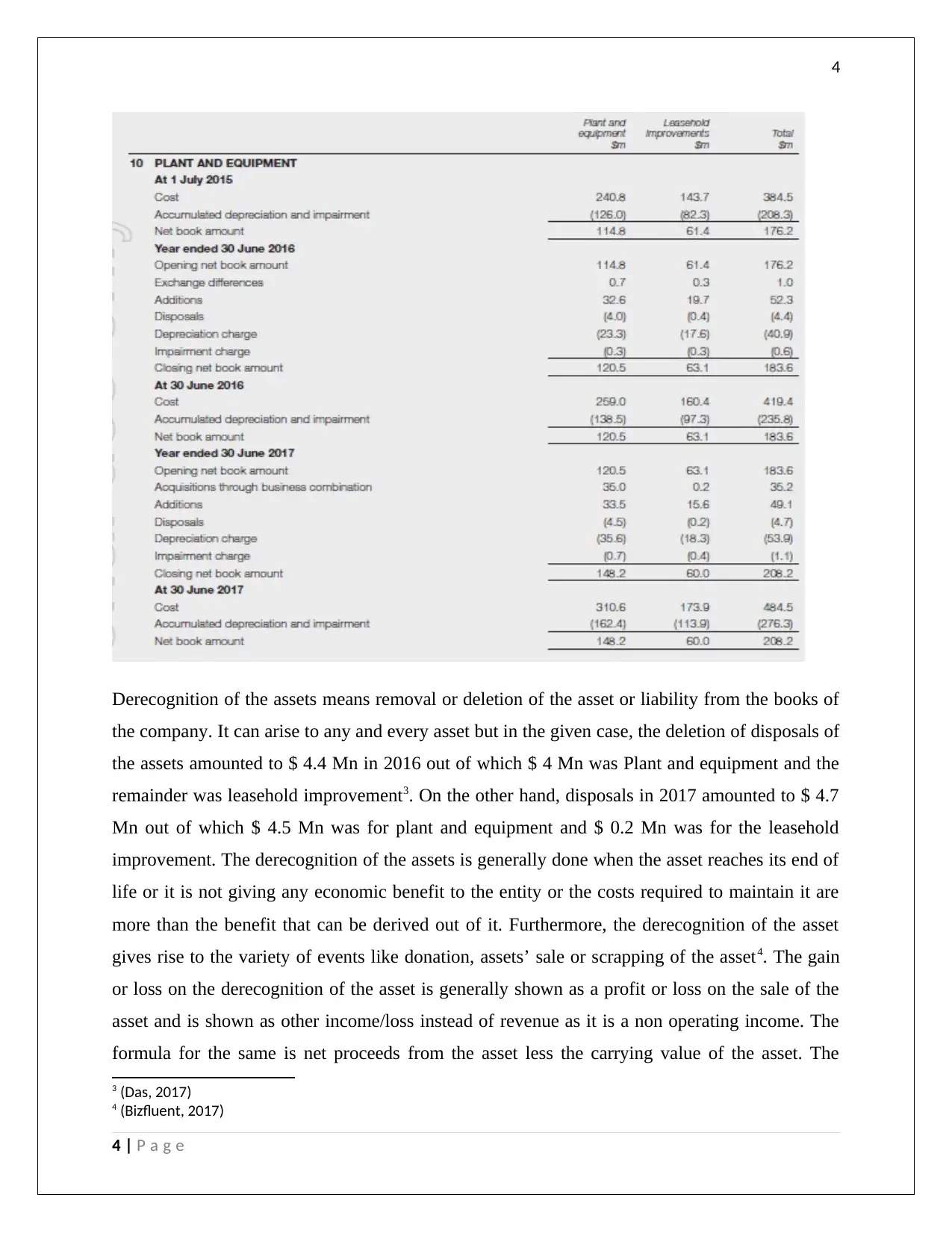
4
Derecognition of the assets means removal or deletion of the asset or liability from the books of
the company. It can arise to any and every asset but in the given case, the deletion of disposals of
the assets amounted to $ 4.4 Mn in 2016 out of which $ 4 Mn was Plant and equipment and the
remainder was leasehold improvement3. On the other hand, disposals in 2017 amounted to $ 4.7
Mn out of which $ 4.5 Mn was for plant and equipment and $ 0.2 Mn was for the leasehold
improvement. The derecognition of the assets is generally done when the asset reaches its end of
life or it is not giving any economic benefit to the entity or the costs required to maintain it are
more than the benefit that can be derived out of it. Furthermore, the derecognition of the asset
gives rise to the variety of events like donation, assets’ sale or scrapping of the asset4. The gain
or loss on the derecognition of the asset is generally shown as a profit or loss on the sale of the
asset and is shown as other income/loss instead of revenue as it is a non operating income. The
formula for the same is net proceeds from the asset less the carrying value of the asset. The
3 (Das, 2017)
4 (Bizfluent, 2017)
4 | P a g e
Derecognition of the assets means removal or deletion of the asset or liability from the books of
the company. It can arise to any and every asset but in the given case, the deletion of disposals of
the assets amounted to $ 4.4 Mn in 2016 out of which $ 4 Mn was Plant and equipment and the
remainder was leasehold improvement3. On the other hand, disposals in 2017 amounted to $ 4.7
Mn out of which $ 4.5 Mn was for plant and equipment and $ 0.2 Mn was for the leasehold
improvement. The derecognition of the assets is generally done when the asset reaches its end of
life or it is not giving any economic benefit to the entity or the costs required to maintain it are
more than the benefit that can be derived out of it. Furthermore, the derecognition of the asset
gives rise to the variety of events like donation, assets’ sale or scrapping of the asset4. The gain
or loss on the derecognition of the asset is generally shown as a profit or loss on the sale of the
asset and is shown as other income/loss instead of revenue as it is a non operating income. The
formula for the same is net proceeds from the asset less the carrying value of the asset. The
3 (Das, 2017)
4 (Bizfluent, 2017)
4 | P a g e
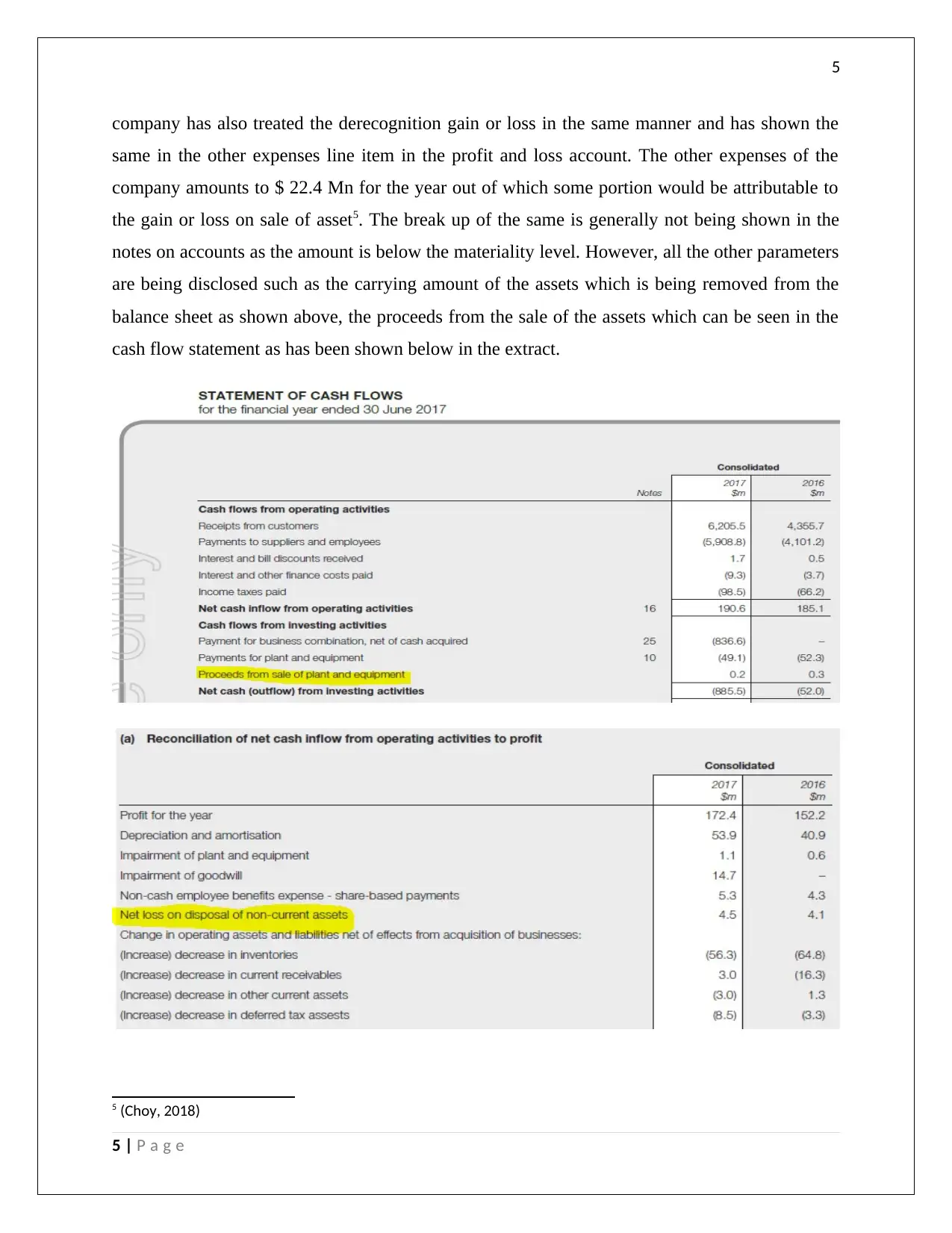
5
company has also treated the derecognition gain or loss in the same manner and has shown the
same in the other expenses line item in the profit and loss account. The other expenses of the
company amounts to $ 22.4 Mn for the year out of which some portion would be attributable to
the gain or loss on sale of asset5. The break up of the same is generally not being shown in the
notes on accounts as the amount is below the materiality level. However, all the other parameters
are being disclosed such as the carrying amount of the assets which is being removed from the
balance sheet as shown above, the proceeds from the sale of the assets which can be seen in the
cash flow statement as has been shown below in the extract.
5 (Choy, 2018)
5 | P a g e
company has also treated the derecognition gain or loss in the same manner and has shown the
same in the other expenses line item in the profit and loss account. The other expenses of the
company amounts to $ 22.4 Mn for the year out of which some portion would be attributable to
the gain or loss on sale of asset5. The break up of the same is generally not being shown in the
notes on accounts as the amount is below the materiality level. However, all the other parameters
are being disclosed such as the carrying amount of the assets which is being removed from the
balance sheet as shown above, the proceeds from the sale of the assets which can be seen in the
cash flow statement as has been shown below in the extract.
5 (Choy, 2018)
5 | P a g e
⊘ This is a preview!⊘
Do you want full access?
Subscribe today to unlock all pages.

Trusted by 1+ million students worldwide
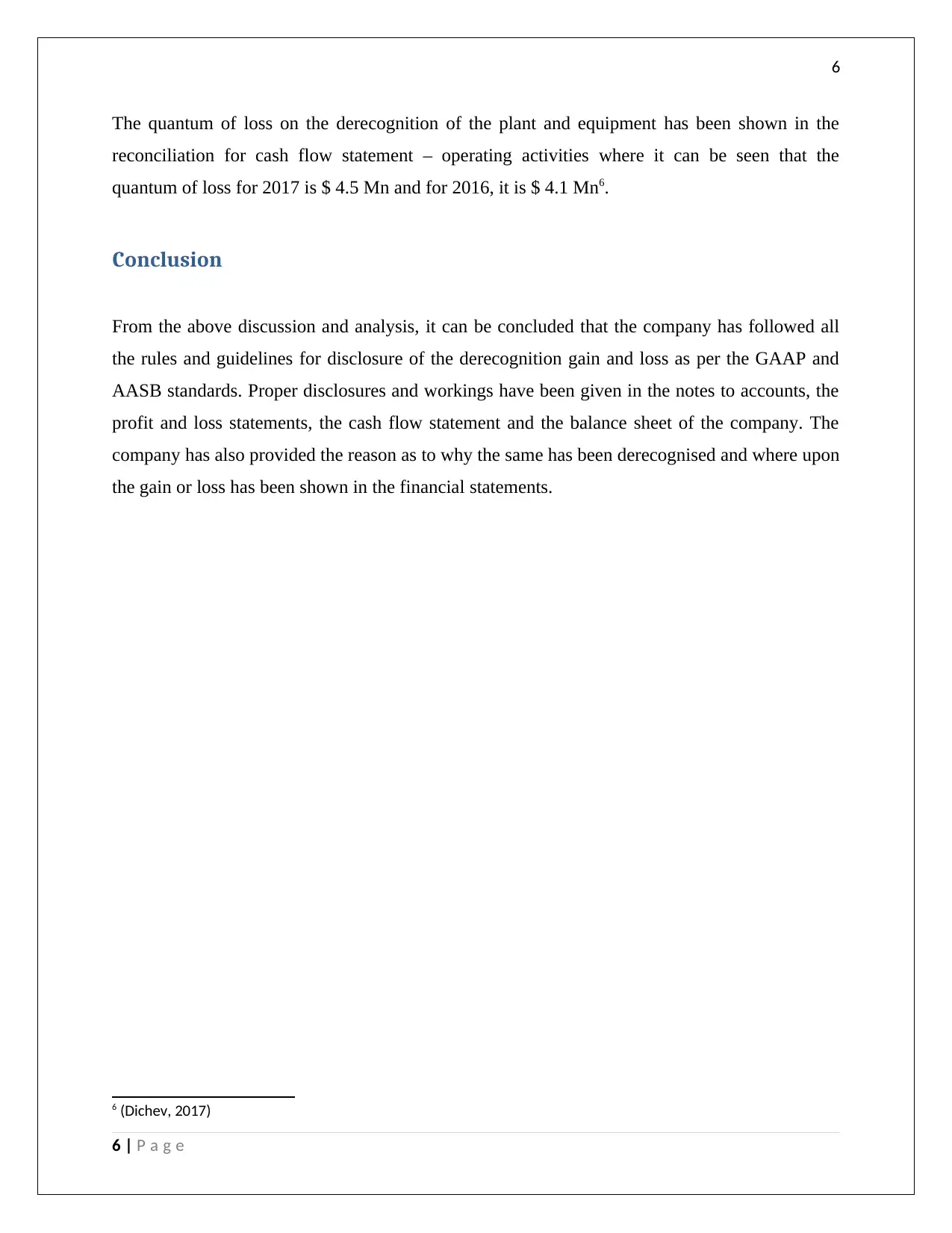
6
The quantum of loss on the derecognition of the plant and equipment has been shown in the
reconciliation for cash flow statement – operating activities where it can be seen that the
quantum of loss for 2017 is $ 4.5 Mn and for 2016, it is $ 4.1 Mn6.
Conclusion
From the above discussion and analysis, it can be concluded that the company has followed all
the rules and guidelines for disclosure of the derecognition gain and loss as per the GAAP and
AASB standards. Proper disclosures and workings have been given in the notes to accounts, the
profit and loss statements, the cash flow statement and the balance sheet of the company. The
company has also provided the reason as to why the same has been derecognised and where upon
the gain or loss has been shown in the financial statements.
6 (Dichev, 2017)
6 | P a g e
The quantum of loss on the derecognition of the plant and equipment has been shown in the
reconciliation for cash flow statement – operating activities where it can be seen that the
quantum of loss for 2017 is $ 4.5 Mn and for 2016, it is $ 4.1 Mn6.
Conclusion
From the above discussion and analysis, it can be concluded that the company has followed all
the rules and guidelines for disclosure of the derecognition gain and loss as per the GAAP and
AASB standards. Proper disclosures and workings have been given in the notes to accounts, the
profit and loss statements, the cash flow statement and the balance sheet of the company. The
company has also provided the reason as to why the same has been derecognised and where upon
the gain or loss has been shown in the financial statements.
6 (Dichev, 2017)
6 | P a g e
Paraphrase This Document
Need a fresh take? Get an instant paraphrase of this document with our AI Paraphraser
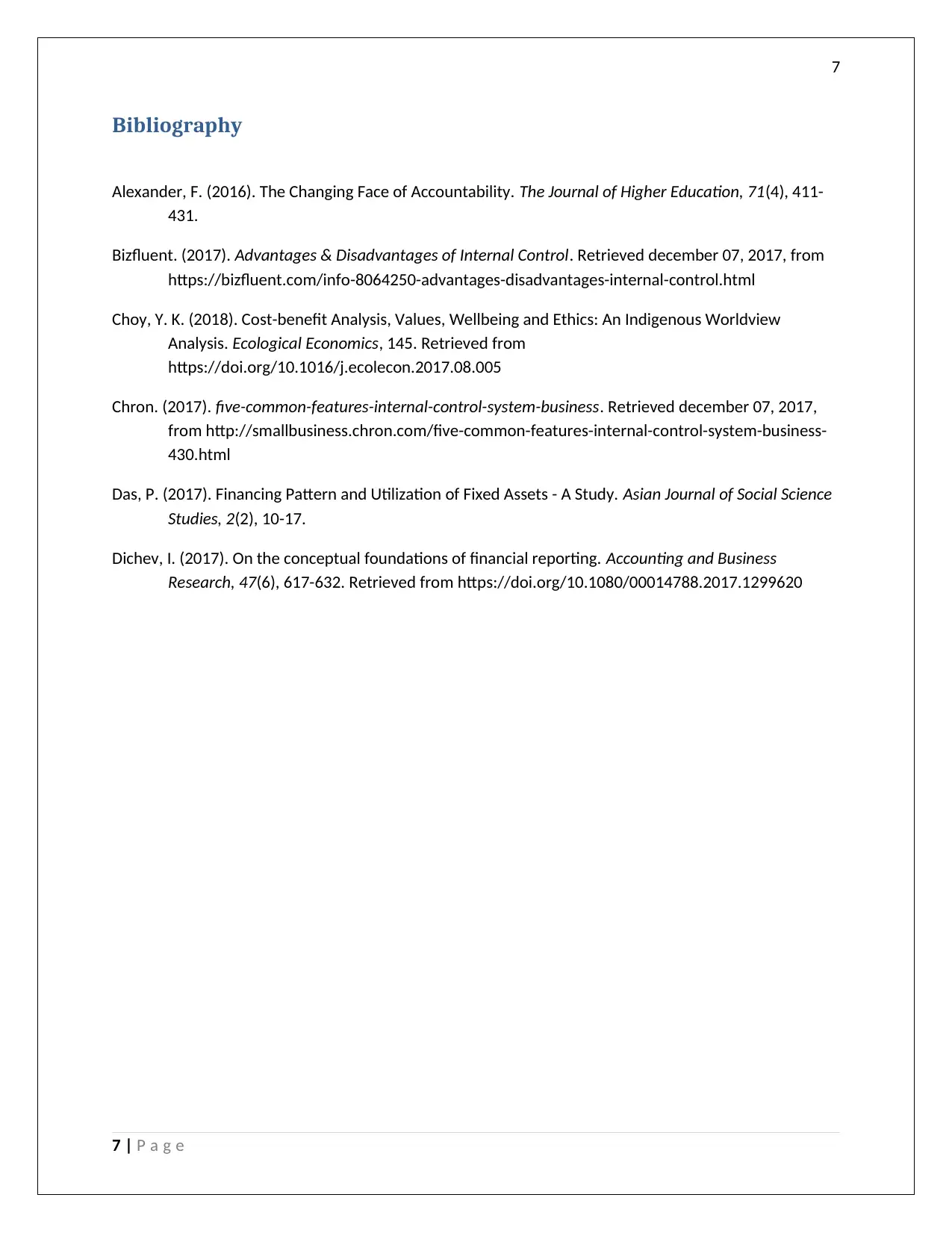
7
Bibliography
Alexander, F. (2016). The Changing Face of Accountability. The Journal of Higher Education, 71(4), 411-
431.
Bizfluent. (2017). Advantages & Disadvantages of Internal Control. Retrieved december 07, 2017, from
https://bizfluent.com/info-8064250-advantages-disadvantages-internal-control.html
Choy, Y. K. (2018). Cost-benefit Analysis, Values, Wellbeing and Ethics: An Indigenous Worldview
Analysis. Ecological Economics, 145. Retrieved from
https://doi.org/10.1016/j.ecolecon.2017.08.005
Chron. (2017). five-common-features-internal-control-system-business. Retrieved december 07, 2017,
from http://smallbusiness.chron.com/five-common-features-internal-control-system-business-
430.html
Das, P. (2017). Financing Pattern and Utilization of Fixed Assets - A Study. Asian Journal of Social Science
Studies, 2(2), 10-17.
Dichev, I. (2017). On the conceptual foundations of financial reporting. Accounting and Business
Research, 47(6), 617-632. Retrieved from https://doi.org/10.1080/00014788.2017.1299620
7 | P a g e
Bibliography
Alexander, F. (2016). The Changing Face of Accountability. The Journal of Higher Education, 71(4), 411-
431.
Bizfluent. (2017). Advantages & Disadvantages of Internal Control. Retrieved december 07, 2017, from
https://bizfluent.com/info-8064250-advantages-disadvantages-internal-control.html
Choy, Y. K. (2018). Cost-benefit Analysis, Values, Wellbeing and Ethics: An Indigenous Worldview
Analysis. Ecological Economics, 145. Retrieved from
https://doi.org/10.1016/j.ecolecon.2017.08.005
Chron. (2017). five-common-features-internal-control-system-business. Retrieved december 07, 2017,
from http://smallbusiness.chron.com/five-common-features-internal-control-system-business-
430.html
Das, P. (2017). Financing Pattern and Utilization of Fixed Assets - A Study. Asian Journal of Social Science
Studies, 2(2), 10-17.
Dichev, I. (2017). On the conceptual foundations of financial reporting. Accounting and Business
Research, 47(6), 617-632. Retrieved from https://doi.org/10.1080/00014788.2017.1299620
7 | P a g e
1 out of 8
Related Documents
Your All-in-One AI-Powered Toolkit for Academic Success.
+13062052269
info@desklib.com
Available 24*7 on WhatsApp / Email
![[object Object]](/_next/static/media/star-bottom.7253800d.svg)
Unlock your academic potential
Copyright © 2020–2025 A2Z Services. All Rights Reserved. Developed and managed by ZUCOL.





